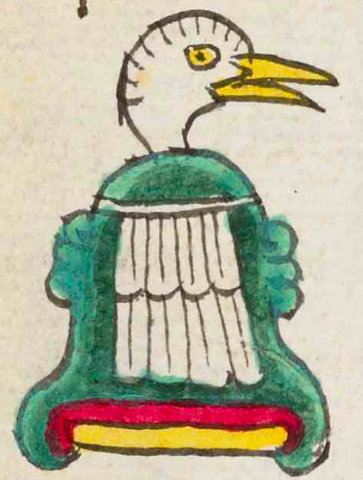Aztaquemecan (Mdz21v)
This place name, Aztaquemecan, consists of the element aztatl (a white heron's head, in this case), quemitl (a garment worn on the chest, like a bib, but for decorative purposes), and the locative -can (represented symbolically—not phonetically—by the tepetl, hill or mountain, which is the typical green, bell shape, rocky outcroppings, and with the horizontal red and yellow lines at its base). The heron's head shows a yellow beak.
Stephanie Wood
The quemitl element will be recognizable to those who have heard of the blouse called a quechquemitl, which is almost as well known as the huipilli. The quemitl in this instance appears to be made from the white feathers of the heron. The cuauhquemitl is more specifically identified by the nature of the feathers (being from an eagle). See below, right, for other examples of the quemitl.
Berdan and Anawalt recognize how aztatl may be translated as either "white heron" or "snowy egret." They refer to the quemitl as a "cape," whereas we usually think of the tilmatli as a cape.
Stephanie Wood
Stephanie Wood
c. 1541, or by 1553 at the latest
Stephanie Wood
herons, garzas, ritual vestments, ritual bibs, prendas rituales, nombres de lugares

azta(tl), Snowy Egret and egret headdress, https://nahuatl.wired-humanities.org/content/aztatl
quemi(tl), garment, bib-like ritual vestment, https://nahuatl.wired-humanities.org/content/quemitl
-can (locative suffix, "where there are"), https://nahuatl.wired-humanities.org/content/can-2
"Place of the White Heron Feather Ritual Vestments" (SW); "Place of the Snowy Egret Feather Capes" or "Place of the White Heron Feather Capes" (Berdan and Anawalt, 1992, vol. 1, p. 175)
Codex Mendoza, folio 21 verso, https://digital.bodleian.ox.ac.uk/objects/2fea788e-2aa2-4f08-b6d9-648c00..., image 53 of 188.
The Bodleian Libraries, University of Oxford, hold the original manuscript, the MS. Arch. Selden. A. 1. This image is published here under the UK Creative Commons, “Attribution-NonCommercial-ShareAlike 3.0 License” (CC-BY-NC-SA 3.0).






